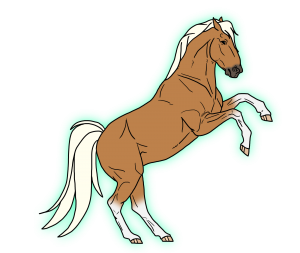Difference between revisions of "Ibren Cob"
RedAttendant (talk | contribs) (Created page with "thumb The Ibren cob, also known as the Ibren pony, is the smallest domestic horse breed found in Aversia. On average, they stand at about 12 hands (...") |
RedAttendant (talk | contribs) m |
||
| Line 52: | Line 52: | ||
[[Category:Common]] | [[Category:Common]] | ||
[[Category:Tameable]] | [[Category:Tameable]] | ||
| + | [[Category:Passive]] | ||
Latest revision as of 01:47, 26 April 2021
The Ibren cob, also known as the Ibren pony, is the smallest domestic horse breed found in Aversia. On average, they stand at about 12 hands (48 in, 122 cm)-13.2 hands (54 in, 137 cm), and weigh in at around 249-272 kg (550-600 lbs). As with most horses, they live to be around 30-35 years old if domestic, and less if feral.
Originating in the Ibren Peninsula of the south, the Ibren cob is a well-rounded horse, despite it's small size. They are stocky and strong, having been bred to be used as cart horses, as well as riding horses. They are considered to be easy keepers, meaning they don't require as much food as other horses, which makes them ideal for people who don't have the money or space to keep larger breeds of horses on their property.
Ibren cobs are varied in their colors; grey, bay, chestnut, black, palomino, buckskin, and dun are the colors that are seen most often, with palomino being the most desired. They never have pinto colors, though it is very common for them to have white markings on their legs and on their faces.
They are very docile and gentle animals, and often eager to please. They are easy to train, and while they don't bond with their riders or handlers as well, they generally have gentle, friendly personalities that makes them pleasant and relatively easy to work with. Even when they're young, they are very relaxed, and it takes a lot to frighten them, though they will still be wary when introduced to new objects or loud noises, and it's still possible for them to bolt out of fear.
They have good stamina, though they are not very fast and are known for their very bouncy trot which tends to make them less desirable for riding horses. They are known for lifting their legs a little higher when they trot, giving them a show gait, and contributes to the bouncy trot, though it has been bred in simply because it looks regal when the horse in harnessed to a buddy or cart.
They are kept by both farmers and nobles; farmers use them to transport goods in cities and towns where the roads are smaller and may not fit a larger horse and wagon, and nobles keep them both to ride and to pull small carts. Squires, children, and those just beginning to learn to ride are commonly those seen riding this breed of horse, due to the fact that they are relaxed, and will not react negatively towards a new or young rider.
Distribution
They are found throughout the south of Aversia and the regions of the savannah and bordering areas around it. There a handful of feral herds on both continents, but the majority of these horses are domestic animals.
Habitat
Like all horses that are feral, Ibren cobs that have gone feral are largely nomadic animals, never staying in one place for too long. This includes the spring and early summer when foals are being born, as foals are able to walk and keep up with their mothers soon after birth. Domestic horses are largely kept in stalls or out in pastures.
Diet
Ibren cobs, as with all horses, are herbivores. The bulk of their diet in the wild is grass, and this can be the case with domestic horses if they are pastured. Otherwise, domestic horses are generally fed hay and various types of dry feed.
Relations
Ibren cobs are docile and eager to please, making them ideal for anyone who might be learning to ride, or is nervous about riding. Horses in the wild will flee from approaching people, but they never attack unless backed into a corner. Feral horses take some work to domestic, but it is possible, even with adults, and they are often indistinguishable from their domestic-born counterparts once they have been trained and handled.
Mechanics
- Good stamina
- Easy to train
- Easy to domesticate
- Hard to startle or scare
Material Properties
- Their fur can be used in clothing.
- Their meat can be eaten, both on its own and mixed in with other foods.
- Their tail hair can be used in string instruments.
Alchemical Properties
- Undiscovered; likely none.
| Geography • Races • Flora • Fauna • Stones • Metals • Cloth • Foreign Continents |
| The World of Aethius • The Multiverse of Aethier |
